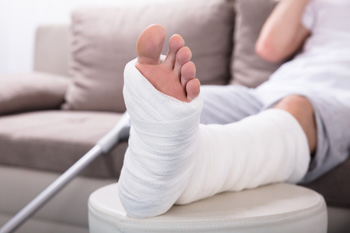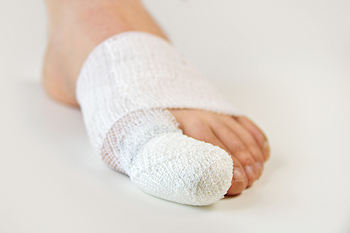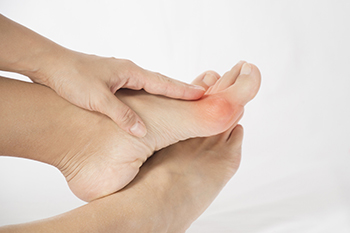Connect With Us
Blog
Items filtered by date: May 2021
Diagnosing Stress Fractures
 A stress fracture is a tiny crack in a bone that often occur in the feet as a result of overuse while playing sports or doing activities that involve running or jumping. Everyday activities can also lead to stress fractures in people with weakened bones. Pain, tenderness, and swelling are usually the first indications of a stress fracture. These symptoms should not be ignored, as stress fractures may worsen over time if left untreated. A podiatrist can diagnose a stress fracture by taking a thorough medical history, completing a physical examination, and ordering imaging studies such as X-rays or bone scans. If you suspect that you may have a stress fracture in your foot or ankle, please see a podiatrist.
A stress fracture is a tiny crack in a bone that often occur in the feet as a result of overuse while playing sports or doing activities that involve running or jumping. Everyday activities can also lead to stress fractures in people with weakened bones. Pain, tenderness, and swelling are usually the first indications of a stress fracture. These symptoms should not be ignored, as stress fractures may worsen over time if left untreated. A podiatrist can diagnose a stress fracture by taking a thorough medical history, completing a physical examination, and ordering imaging studies such as X-rays or bone scans. If you suspect that you may have a stress fracture in your foot or ankle, please see a podiatrist.
Activities where too much pressure is put on the feet can cause stress fractures. To learn more, contact Scott Matthews, DPM, MD from Salem Foot Care . Our doctor can provide the care you need to keep your pain free and on your feet.
Dealing with Stress Fractures of the Foot and Ankle
Stress fractures occur in the foot and ankle when muscles in these areas weaken from too much or too little use. The feet and ankles then lose support when walking or running from the impact of the ground. Since there is no protection, the bones receive the full impact of each step. Stress on the feet can cause cracks to form in the bones, thus creating stress fractures.
What Are Stress Fractures?
Stress fractures occur frequently in individuals whose daily activities cause great impact on the feet and ankles. Stress factors are most common among:
- Runners
- People affected with Osteoporosis
- Tennis or basketball players
- Gymnasts
- High impact workouts
Symptoms
Pain from the fractures occur in the area of the fractures and can be constant or intermittent. It will often cause sharp or dull pain with swelling and tenderness. Engaging in any kind of activity which involves high impact will aggravate pain.
If you have any questions please feel free to contact our office located in Wikesboro, NC . We offer the newest diagnostic and treatment technologies for all your foot and ankle needs.
Types of Painful Toe Conditions
 There are a variety of painful conditions that can impact the feet, and many of those can cause pain in the toes. Pain and swelling around the toenails where the nail has curled into the skin is a common sign of ingrown toenails. Bunions are formed near the big toe as painful bony lumps that form due to poorly fitting shoes. If any toes are broken, the toes will become painful and swollen, and walking could be difficult. If there is pain and stiffness around the joints, and they feel hot and swollen, that may be a sign of gout, which is affected by the level of uric acid in the blood. If the pain in the toes is severe, gets worse, results in a loss of sensation, or you are diabetic, consulting with a podiatrist is suggested. A podiatrist will be able to diagnose and provide treatment options for pain that is in the toes and feet.
There are a variety of painful conditions that can impact the feet, and many of those can cause pain in the toes. Pain and swelling around the toenails where the nail has curled into the skin is a common sign of ingrown toenails. Bunions are formed near the big toe as painful bony lumps that form due to poorly fitting shoes. If any toes are broken, the toes will become painful and swollen, and walking could be difficult. If there is pain and stiffness around the joints, and they feel hot and swollen, that may be a sign of gout, which is affected by the level of uric acid in the blood. If the pain in the toes is severe, gets worse, results in a loss of sensation, or you are diabetic, consulting with a podiatrist is suggested. A podiatrist will be able to diagnose and provide treatment options for pain that is in the toes and feet.
Foot Pain
Foot pain can be extremely painful and debilitating. If you have a foot pain, consult with Scott Matthews, DPM, MD from Salem Foot Care . Our doctor will assess your condition and provide you with quality foot and ankle treatment.
Causes
Foot pain is a very broad condition that could be caused by one or more ailments. The most common include:
- Bunions
- Hammertoes
- Plantar Fasciitis
- Bone Spurs
- Corns
- Tarsal Tunnel Syndrome
- Ingrown Toenails
- Arthritis (such as Gout, Rheumatoid, and Osteoarthritis)
- Flat Feet
- Injury (from stress fractures, broken toe, foot, ankle, Achilles tendon ruptures, and sprains)
- And more
Diagnosis
To figure out the cause of foot pain, podiatrists utilize several different methods. This can range from simple visual inspections and sensation tests to X-rays and MRI scans. Prior medical history, family medical history, and any recent physical traumatic events will all be taken into consideration for a proper diagnosis.
Treatment
Treatment depends upon the cause of the foot pain. Whether it is resting, staying off the foot, or having surgery; podiatrists have a number of treatment options available for foot pain.
If you have any questions, please feel free to contact our office located in Wikesboro, NC . We offer the newest diagnostic and treatment technologies for all your foot care needs.
Women and Bunions
 Women usually are more likely to develop bunions more frequently than men. They can gradually form as a result of wearing high heels or shoes that do not have adequate room for the toes to move freely in. A noticeable symptom of a bunion can consist of a large and bony protrusion that is positioned on the side of the big toe. It can be accompanied by pain and discomfort, and it may be difficult to wear shoes. Some patients find relief by frequently performing specific stretches, or wearing a cushion inside the shoe. If you notice a bunion that is beginning to develop, it is suggested that you schedule an appointment with a podiatrist who can offer you treatment options, which may include surgery for permanent removal.
Women usually are more likely to develop bunions more frequently than men. They can gradually form as a result of wearing high heels or shoes that do not have adequate room for the toes to move freely in. A noticeable symptom of a bunion can consist of a large and bony protrusion that is positioned on the side of the big toe. It can be accompanied by pain and discomfort, and it may be difficult to wear shoes. Some patients find relief by frequently performing specific stretches, or wearing a cushion inside the shoe. If you notice a bunion that is beginning to develop, it is suggested that you schedule an appointment with a podiatrist who can offer you treatment options, which may include surgery for permanent removal.
If you are suffering from bunion pain, contact Scott Matthews, DPM, MD of Salem Foot Care . Our doctor can provide the care you need to keep you pain-free and on your feet.
What Is a Bunion?
Bunions are painful bony bumps that usually develop on the inside of the foot at the joint of the big toe. As the deformity increases over time, it may become painful to walk and wear shoes. Women are more likely to exacerbate existing bunions since they often wear tight, narrow shoes that shift their toes together. Bunion pain can be relieved by wearing wider shoes with enough room for the toes.
Causes
- Genetics – some people inherit feet that are more prone to bunion development
- Inflammatory Conditions - rheumatoid arthritis and polio may cause bunion development
Symptoms
- Redness and inflammation
- Pain and tenderness
- Callus or corns on the bump
- Restricted motion in the big toe
In order to diagnose your bunion, your podiatrist may ask about your medical history, symptoms, and general health. Your doctor might also order an x-ray to take a closer look at your feet. Nonsurgical treatment options include orthotics, padding, icing, changes in footwear, and medication. If nonsurgical treatments don’t alleviate your bunion pain, surgery may be necessary.
If you have any questions, please feel free to contact our office located in Wikesboro, NC . We offer the newest diagnostic and treatment technologies for all your foot care needs.
When Should I Get My Child New Shoes?
Children's feet grow and change quite rapidly throughout childhood. It is very important to make sure that your child is wearing the right shoes to protect their feet, as well as prevent foot pain and injuries. Since children’s feet tend to grow quickly, it can be difficult to determine whether your child needs new shoes. After all, you just bought a new pair two months ago - could your child have outgrown them already? You should look for new shoes if your child can no longer fit their foot comfortably or wiggle their toes within their current shoes. New shoes should also be purchased if the sole of the shoe is broken or torn as well as if your child is limping or if you notice a different walking pattern. To learn more about the connections between footwear and your child’s foot health, please speak with a podiatrist.
Making sure that your children maintain good foot health is very important as they grow. If you have any questions, contact Scott Matthews, DPM, MD of Salem Foot Care . Our doctor can provide the care you need to keep you pain-free and on your feet.
Keeping Children's Feet Healthy
Having healthy feet during childhood can help prevent medical problems later in life, namely in the back and legs. As children grow, their feet require different types of care. Here are some things to consider...
Although babies do not walk yet, it is still very important to take care of their feet.
Avoid putting tight shoes or socks on his or her feet.
Allow the baby to stretch and kick his or her feet to feel comfortable.
As a toddler, kids are now on the move and begin to develop differently. At this age, toddlers are getting a feel for walking, so don’t be alarmed if your toddler is unsteady or ‘walks funny’.
As your child gets older, it is important to teach them how to take care of their feet.
Show them proper hygiene to prevent infections such as fungus.
Be watchful for any pain or injury.
Have all injuries checked by a doctor as soon as possible.
Comfortable, protective shoes should always be worn, especially at play.
If you have any questions please feel free to contact our office located in Wikesboro, NC . We offer the newest diagnostic and treatment technologies for all your foot and ankle needs.
Blog Archives
- March 2025
- February 2025
- January 2025
- December 2024
- November 2024
- October 2024
- September 2024
- August 2024
- July 2024
- June 2024
- May 2024
- April 2024
- March 2024
- February 2024
- January 2024
- December 2023
- November 2023
- October 2023
- September 2023
- August 2023
- July 2023
- June 2023
- May 2023
- April 2023
- March 2023
- February 2023
- January 2023
- December 2022
- November 2022
- October 2022
- September 2022
- August 2022
- July 2022
- June 2022
- May 2022
- April 2022
- March 2022
- February 2022
- January 2022
- December 2021
- November 2021
- October 2021
- September 2021
- August 2021
- July 2021
- June 2021
- May 2021
- April 2021
- March 2021
- February 2021
- January 2021
- December 2020
- November 2020
- October 2020
- September 2020
- August 2020
- July 2020
- June 2020
- May 2020
- April 2020
- March 2020
- February 2020
- January 2020
- December 2019
- November 2019
- October 2019
- September 2019
- August 2019
- July 2019
- June 2019
- May 2019
- April 2019
- March 2019
- February 2019
- January 2019
- December 2018
- November 2018
- October 2018
- September 2018
- August 2018
- July 2018
- June 2018
- May 2018


